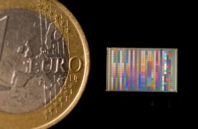The Fraunhofer Institute for Integrated Circuits (IIS) in Erlangen and the Fraunhofer Institute for Silicate Research (ISC) in Würzburg, both Germany, have co-developed novel color sensors with a special microlens arrangement.
The sensors, developed in the FOWINA project, can be formed directly on a chip and they combine multiple functions in a minimum of space, say the developers. “Their extremely slim design makes the sensors suitable for a wide range of applications, such as in mobile devices or color-adjustable LED lamps,” states the associated announcement. FOWINA stands for “controlling angular spectrum of nanostructured color sensors by micro-optical beam-shaping elements.”
Such color sensors could be used in displays, LEDs and other devices to generate true colors. Their fabrication involves the use of special nanoplasmonic structures. These structures filter the incident light, allowing only precisely defined regions of the color spectrum to reach the detector surface.

 (585) 768-2513
(585) 768-2513

